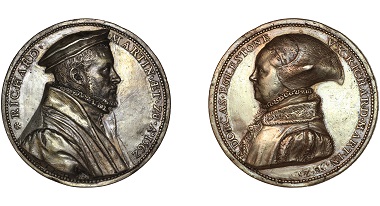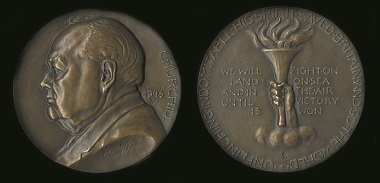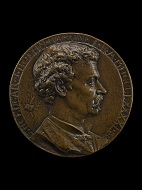November 8, 2018 – The British Museum presents a new exhibition called “Witnesses: émigré medallists in Britain”, sponsored by Spink, which can be visited until April 7, 2019. This focussed exhibition uncovers the invaluable role played by artists from abroad in the development of British medallic art. On display are medals that span six centuries, documenting significant historical moments and commemorating famous British figures. This new exhibition uses objects to tell an international story, as it explores the motivations that brought artists to Britain and the ways in which they enlivened this country’s medallic landscape.
Steven van Herwijck: Richard Martin and Dorcas Eglestone, 1562, silver, 57mm. © Trustees of the British Museum. In the 1560s the Netherlandish medallist van Herwijck made two extended trips to London, where he made various medals of British subjects.
The earliest works in the exhibition are from Elizabethan England. It was the Dutch artist Steven van Herwijck who introduced the art of the medal, already well-established on this continent, to Britain’s urban elite. Van Herwijck’s first visit to England was of short duration, but three years later he returned with his wife and children. Medals have been made continuously in this country ever since.
Benedetto Pistrucci: Coronation of George IV, 1821, gold, 35mm. © Trustees of the British Museum. Pistrucci came to England in 1815. From 1817 until his death in 1855 he was Chief Engraver / Medallist at the Royal Mint.
One of the star objects on display will be a spectacular Waterloo medal conceived by 19thcentury Italian gem engraver Benedetto Pistrucci. This medal took 30 years to complete and bears the image of the four allied sovereigns George, Prince Regent, Francis II of Austria, Alexander I of Russia and King Frederick William III of Prussia. Although the story of each medallist who arrived over the centuries is unique, for many a position at the Royal Mint was coveted and considered the ultimate goal. Pistrucci was successful in this ambition as he arrived from Italy in 1815 and became Chief Medallist at the Royal Mint. Today Pistrucci remains a renowned medallist and coin-engraver, known for producing a number of famous designs during his career, most notably the George and Dragon for the sovereign.
Arthur Loewental: Winston Churchill, 1945, bronze, 64mm. © Trustees of the British Museum. Loewental came to Britain from Austria in 1934 to escape the Nazis, living in Lincoln until his death in 1964.
During the 1930s a number of medallists fleeing Nazi oppression sought refuge in Britain. This was a time when few British artists engaged with the medium, and so the contributions made to medallic art by Fred Kormis, Artur Loewental and Paul Vincze (from Germany, Austria and Hungary respectively) have a special significance.
Paul Vincze: The Pilgrim Fathers, 1957, bronze, 57mm. © Trustees of the British Museum. The Hungarian Vincze fled Nazi persecution in 1938. In the decades following the Second World War he became the most important medallist working in the UK.
Vincze summed up the question of nationality in 1975 when he stated: ‘I am Hungarian. My wife is French. We are British.’ This exhibition will showcase Vincze’s medals commemorating victory in 1945, the coronation of 1953, and anniversaries of the battle of Trafalgar and the resettlement of Jews in Britain. Alongside these will be Loewental’s commemorative medal of Winston Churchill, inscribed ‘his spirit saved Britain’. Together these objects reveal the ways in which artists from abroad identified strongly with the country to which they had come.
Edouard Lanteri: J. E. Boehm, 1891, bronze, 118mm. © Trustees of the British Museum. Lanteri came to London from France in 1872 as a political exile and from 1874 taught at the National Art Training School (now the Royal College of Art), becoming Professor of Sculpture in 1890. The Austrian Boehm, the subject of this medal, was appointed Sculptor in Ordinary to Queen Victoria in 1881 and also made medals.
This display will also reveal that while their skill was undeniable, the presence of artists from abroad sometimes led to rivalry with British-born medallists. Following the restoration of Charles II in 1660, London-born Thomas Simon found himself in direct competition with John (formerly Jan) Roettiers, whilst the hostility between Pistrucci and William Wyon remained in place throughout the first half of the 19th century.
Danuta Solowiej: Oxford Botanic Garden Sibthorp Prize, 2001, bronze, 78mm. © Trustees of the British Museum. Solowiej studied sculpture in Warsaw, moving to Britain in 1988. Since then she has lived in London.
Bringing the exhibition up to present times, medals conceived by artists working today will also be on display. Medals by contemporary artist Danuta Solowiej will include a commission from the University of Oxford’s Department of Plant Sciences, with a beautiful rendition of the Iris germanica. Solowiej learned the art of medal making in Poland and has now been working in London for thirty years. The exhibition also celebrates works by Asian artists Dhruva Mistry RA from India and a young silversmith from Korea, Kyosun Jung, who is currently working in London.
It is generally recognised that the story of British art before the 19th century is, to a great extent, the story of artists arriving from other countries. Witnesses: émigré medallists in Britain brings together a selection of objects to reveal that this also true of medallic art. Drawing on the British Museum’s rich medal collection, this exhibition celebrates the contributions made by foreign artists both past and present.
Hartwig Fischer, Director of the British Museum, said “I am delighted that we are opening the second in a series of displays here at the British Museum, thanks to our sponsorship with Spink. The medals featured in this display demonstrate how different cultures have interacted with one another throughout the history of medallic art. I look forward to our visitors seeing this display, and discovering the influence of émigré medallists in Britain.”
Olivier Stocker, Chairman and CEO of Spink, said: “In the world today, the plight of emigrants and the impact of immigration divides public opinion, so it is important to celebrate the positive effect these émigré medallists made on the design of medals commemorating British events from the 16th century to the present day. Thoughtfully curated by the British Museum’s Philip Attwood, there is much here to enjoy.”
Philip Attwood, Keeper of the Coins and Medals department at the British Museum said, “This display gives the British Museum an opportunity to highlight the contribution of foreign artists to medallic art. Artists from abroad continue to contribute to the British medallic revival and the objects displayed here reveal that the medium has been enriched by the diverse cultures from which the artists have come.”
Talks on the exhibition by its curator, Philip Attwood, will be held in Gallery 69a on Tuesday 27 November 2018 and Wednesday 30 January 2019.
More information on this exhibition is available on the British Museum website.









